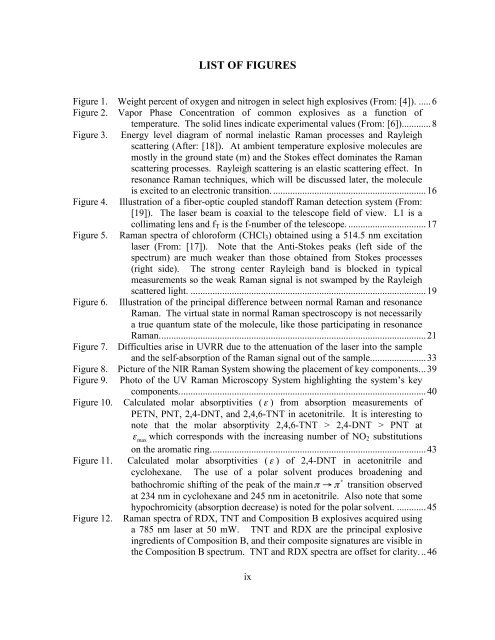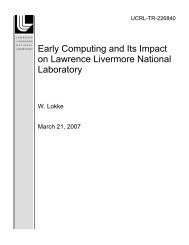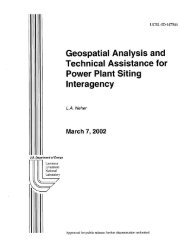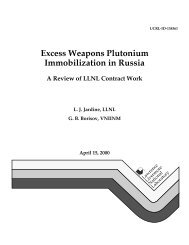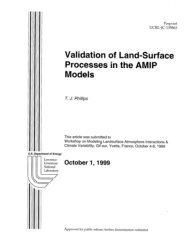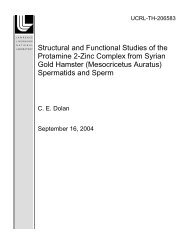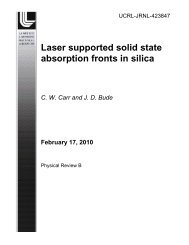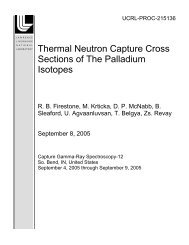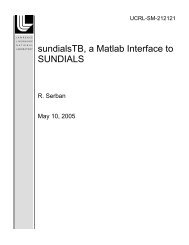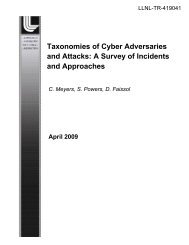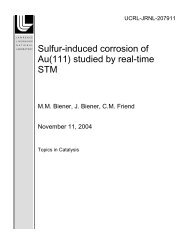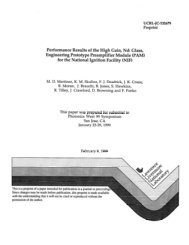Ultraviolet Resonant Raman Enhancements in the Detection of ...
Ultraviolet Resonant Raman Enhancements in the Detection of ...
Ultraviolet Resonant Raman Enhancements in the Detection of ...
Create successful ePaper yourself
Turn your PDF publications into a flip-book with our unique Google optimized e-Paper software.
LIST OF FIGURES<br />
Figure 1. Weight percent <strong>of</strong> oxygen and nitrogen <strong>in</strong> select high explosives (From: [4]). .....6 <br />
Figure 2. Vapor Phase Concentration <strong>of</strong> common explosives as a function <strong>of</strong><br />
temperature. The solid l<strong>in</strong>es <strong>in</strong>dicate experimental values (From: [6])............8 <br />
Figure 3. Energy level diagram <strong>of</strong> normal <strong>in</strong>elastic <strong>Raman</strong> processes and Rayleigh<br />
scatter<strong>in</strong>g (After: [18]). At ambient temperature explosive molecules are<br />
mostly <strong>in</strong> <strong>the</strong> ground state (m) and <strong>the</strong> Stokes effect dom<strong>in</strong>ates <strong>the</strong> <strong>Raman</strong><br />
scatter<strong>in</strong>g processes. Rayleigh scatter<strong>in</strong>g is an elastic scatter<strong>in</strong>g effect. In<br />
resonance <strong>Raman</strong> techniques, which will be discussed later, <strong>the</strong> molecule<br />
is excited to an electronic transition. ...............................................................16 <br />
Figure 4. Illustration <strong>of</strong> a fiber-optic coupled stand<strong>of</strong>f <strong>Raman</strong> detection system (From:<br />
[19]). The laser beam is coaxial to <strong>the</strong> telescope field <strong>of</strong> view. L1 is a<br />
collimat<strong>in</strong>g lens and fT is <strong>the</strong> f-number <strong>of</strong> <strong>the</strong> telescope. ................................17 <br />
Figure 5. <strong>Raman</strong> spectra <strong>of</strong> chlor<strong>of</strong>orm (CHCl3) obta<strong>in</strong>ed us<strong>in</strong>g a 514.5 nm excitation<br />
laser (From: [17]). Note that <strong>the</strong> Anti-Stokes peaks (left side <strong>of</strong> <strong>the</strong><br />
spectrum) are much weaker than those obta<strong>in</strong>ed from Stokes processes<br />
(right side). The strong center Rayleigh band is blocked <strong>in</strong> typical<br />
measurements so <strong>the</strong> weak <strong>Raman</strong> signal is not swamped by <strong>the</strong> Rayleigh<br />
scattered light. .................................................................................................19 <br />
Figure 6. Illustration <strong>of</strong> <strong>the</strong> pr<strong>in</strong>cipal difference between normal <strong>Raman</strong> and resonance<br />
<strong>Raman</strong>. The virtual state <strong>in</strong> normal <strong>Raman</strong> spectroscopy is not necessarily<br />
a true quantum state <strong>of</strong> <strong>the</strong> molecule, like those participat<strong>in</strong>g <strong>in</strong> resonance<br />
<strong>Raman</strong>..............................................................................................................21 <br />
Figure 7. Difficulties arise <strong>in</strong> UVRR due to <strong>the</strong> attenuation <strong>of</strong> <strong>the</strong> laser <strong>in</strong>to <strong>the</strong> sample<br />
and <strong>the</strong> self-absorption <strong>of</strong> <strong>the</strong> <strong>Raman</strong> signal out <strong>of</strong> <strong>the</strong> sample.......................33 <br />
Figure 8. Picture <strong>of</strong> <strong>the</strong> NIR <strong>Raman</strong> System show<strong>in</strong>g <strong>the</strong> placement <strong>of</strong> key components...39 <br />
Figure 9. Photo <strong>of</strong> <strong>the</strong> UV <strong>Raman</strong> Microscopy System highlight<strong>in</strong>g <strong>the</strong> system’s key<br />
components......................................................................................................40 <br />
Figure 10. Calculated molar absorptivities ( ) from absorption measurements <strong>of</strong><br />
PETN, PNT, 2,4-DNT, and 2,4,6-TNT <strong>in</strong> acetonitrile. It is <strong>in</strong>terest<strong>in</strong>g to<br />
note that <strong>the</strong> molar absorptivity 2,4,6-TNT > 2,4-DNT > PNT at<br />
which corresponds with <strong>the</strong> <strong>in</strong>creas<strong>in</strong>g number <strong>of</strong> NO2 substitutions<br />
on <strong>the</strong> aromatic r<strong>in</strong>g.........................................................................................43 <br />
Figure 11. Calculated molar absorptivities ( ) <strong>of</strong> 2,4-DNT <strong>in</strong> acetonitrile and<br />
cyclohexane. The use <strong>of</strong> a polar solvent produces broaden<strong>in</strong>g and<br />
bathochromic shift<strong>in</strong>g <strong>of</strong> <strong>the</strong> peak <strong>of</strong> <strong>the</strong> ma<strong>in</strong> transition observed<br />
at 234 nm <strong>in</strong> cyclohexane and 245 nm <strong>in</strong> acetonitrile. Also note that some<br />
hypochromicity (absorption decrease) is noted for <strong>the</strong> polar solvent. ............45 <br />
Figure 12. <strong>Raman</strong> spectra <strong>of</strong> RDX, TNT and Composition B explosives acquired us<strong>in</strong>g<br />
a 785 nm laser at 50 mW. TNT and RDX are <strong>the</strong> pr<strong>in</strong>cipal explosive<br />
<strong>in</strong>gredients <strong>of</strong> Composition B, and <strong>the</strong>ir composite signatures are visible <strong>in</strong><br />
<strong>the</strong> Composition B spectrum. TNT and RDX spectra are <strong>of</strong>fset for clarity...46 <br />
ix


